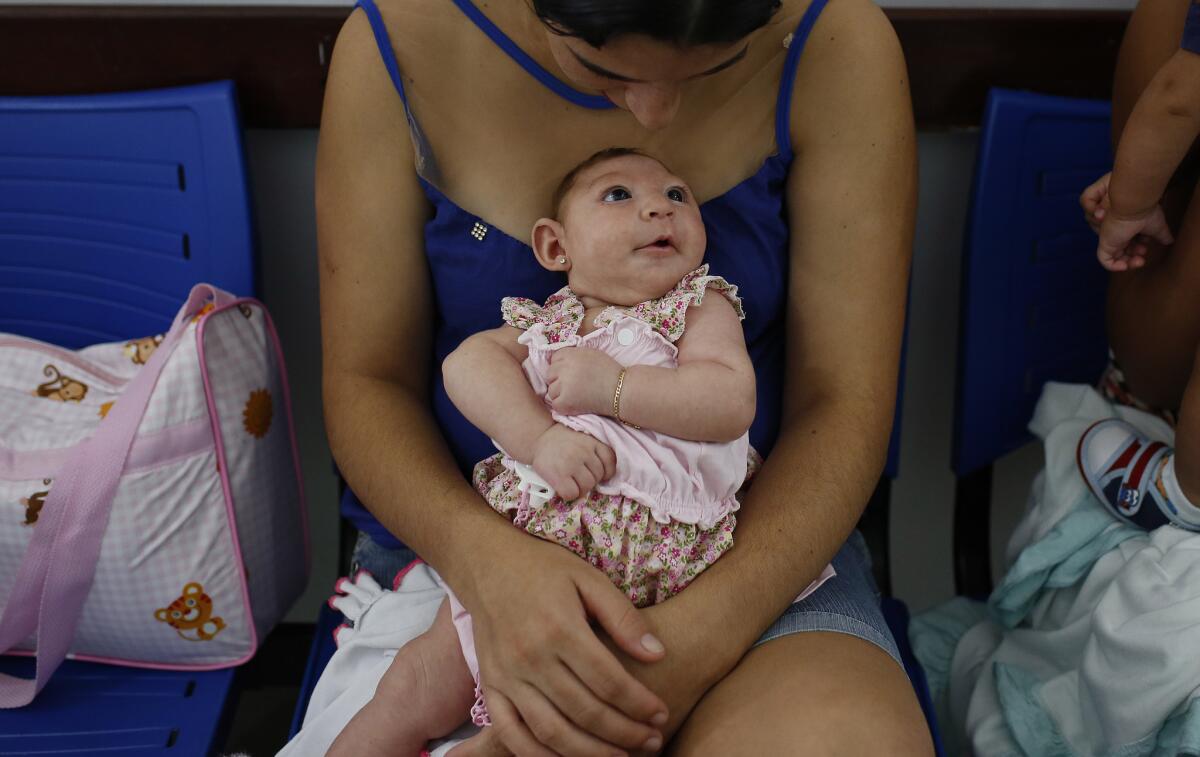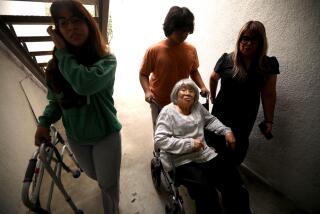On the frontline of Brazil’s war with Zika, a mother’s first question: ‘How big is the head?’

Maria Silva Flor, 20, holds her 2-month-old baby, Maria Alves, who was born with microcephaly.
- Share via
CAMPINA GRANDE, Brazil — It’s 7:30 a.m. and the hallway outside the neurosurgeon’s office at the Pedro I Municipal Hospital is filling with mothers and their babies.The women arrive with questions: Will their children ever learn to walk? Will they ever speak?
The doctor, Alba Batista, wishes she had answers.
She used to see two, maybe three cases of microcephaly a year. But since December, more than 40 newborns with the condition — an abnormally small skull, often with an underdeveloped brain — have shown up at Pedro I.
Thousands of other cases have been reported across Brazil since the fall, a surge that researchers link to the Zika virus.
Batista wraps a tape measure around the head of a crying baby boy as seven medical students gather around. She shines a light into each of his eyes and tickles his stomach with a brush to watch his reaction.
Holding a brain scan up to the light, she points out telltale lesions and calcium deposits. The baby’s brain is damaged, but the doctor has seen worse.
“There’s a possibility that he will develop better,” she tells his mother. “Are we sure? No.”
Tears well up in the mother’s eyes.
So many babies. So much bad news to deliver.
Asked what the future is for these children, Batista turns to wipe away her own tears.
Who knows? “Only God,” she says. “Here, we are humans.”
Desperate for good news
Pedro I is the oldest hospital in Campina Grande, a city of 400,000 where everybody seems to be talking about the strange epidemic of babies with small heads.
The patients come from across Paraiba, one of nine states in the vast northeastern part of Brazil that accounts for the majority of microcephaly cases.
Local health clinics offer routine checkups, but seeing a specialist can mean traveling 200 miles each way to Pedro I.
A squat, two-story structure with a whitewashed facade, the hospital now houses one of the country’s first microcephaly centers. It occupies three small rooms along a narrow hallway. Purple pompoms decorate the doors, breaking the monotony of the gray tile floors and scuffed walls.
The center has assembled a team of experts to care for the babies and organizes support groups for the mothers. But doctors here worry that many families seem to be in denial, clinging to the idea that microcephaly is simply a matter of head size.
At this stage, the babies can do most of the things as others the same age. But the condition can be accompanied by vision, hearing, learning and motor problems that require lifelong care.
What doctors suspect from looking at brain scans — but nobody knows for sure — is that the damage caused by the Zika virus is often worse than from other causes of microcephaly, including genetic disorders and drug or alcohol use during pregnancy.
Plans are in the works for a new wing to accommodate more therapy rooms and equipment the children will need as they grow older. Resources are tight, though.
The outbreak of Zika, a mosquito-borne virus that did not begin to spread widely in the Americas until last spring, could not have happened at a worse time, in the midst of Brazil’s worst recession in 80 years and a political crisis in which the president could be impeached.
In Rio de Janeiro, hospitals and clinics temporarily cut back their services because salaries went unpaid and gloves, medicines and other basic supplies ran out.
Pedro I has avoided the worst of those problems. The hospital is more than a treatment center. It has become a refuge for families, a place where parents can find comfort and camaraderie amid all the uncertainty.
More questions than answers
In Room 114, the hospital’s only physiotherapist, Jeime Leal, hoists 4-month-old Gilberto onto a bright yellow exercise ball. The baby throws back his head and wails.
“Oh Gilberto, how handsome you are!” Leal says in a soothing voice, as she rocks the ball from side to side. “You don’t need to be like this. I’m just helping you.”
The hope is that early stimulation and exercises will improve his development. But Gilberto’s weak neck makes it difficult for him to hold a seated position on the moving ball.
His mother, Josemary Gomes, hates to watch him cry and slips out of the room.
The sessions are conducted on a lime-green mat that takes up most of the cramped space that doubles as Leal’s office. Two rag dolls sit on the windowsill, and cardboard flowers and hearts decorate the walls.
Gilberto won’t let up. His mother had to wake him up at 3:45 a.m. to catch a free municipal van to Pedro I. Gomes, who is raising four boys on her own, can’t afford the bus fare.
She used to make a living as a cook and cleaner. “My only work now is taking care of Gilberto,” she says.
They spend the rest of the morning waiting. The van that will take them home doesn’t leave until all the passengers are finished with their appointments.
In the six years that Leal worked at a pediatrician’s office, she never had a microcephaly case. When she started at Pedro I in December, there were seven cases at the hospital. She now sees twice that number in a single day.
Leal set up a group on the WhatsApp chat service so the mothers can ask questions and share experiences. When she gets home that night, her phone lights up with messages.
‘We’ve become a family here’
In the hallway outside Room 114, mothers share coffee, cake and news about their babies.
When one young couple cannot console their distraught daughter, a more experienced mother takes the child and paces the hallway until she stops crying.
“I do the same thing with my daughter,” says Celeneide de Sales Silva as she returns the infant to her parents.
Her daughter, 3-month-old Yane, is the only child with microcephaly in their small town of Soledade.
“People come up to me and want to look at the size of her head,” she says. “They are surprised because they think her head is not that small. They say babies with microcephaly are ugly babies.”
It’s different at Pedro I, she says: “We’ve become a family here.”
Waiting and worrying
In the waiting room for the hospital’s only CT scanner, sweat beads down Sidnayde dos Santos’ forehead as she sits with her 19-year-old daughter and 3-month-old grandson.
There is no air conditioning, and the temperature soars as the afternoon drags on. A movie dubbed into Portuguese plays on a small television, but none of the half-dozen or so patients is watching.
The family has been waiting two hours when a staff member comes in and makes an announcement: The scanner is broken. A technician has been summoned to fix it.
Dos Santos groans. “This is Brazil,” she explains.
It takes an hour and a half to repair the machine.
Finally, Amanda dos Santos and her son, Emanuel, enter the scan room.
“He doesn’t look like a baby with microcephaly,” a woman waiting with her teenage son tells Dos Santos. “Does he cry a lot?” she wants to know.
Not at all when he was born, replies Dos Santos, who delivered her grandson at home and doesn’t think there is anything seriously wrong with him. “I had to slap him,” she says.
Another woman suggests that she advise her daughter not to have more children.
Dos Santos ignores the comment. Each day at home she and her daughter put Emanuel through the exercises the therapist showed them. They say they can already see improvements.
When her daughter emerges from the CT room, Dos Santos wraps Emanuel in a white eyelet blanket and kisses his forehead. “See how strong he is,” she says.
How big is the head?
Room 117 is where pregnant women come to learn the results of their ultrasound tests. Once, most just wanted to know: Is it a boy or a girl?
These days, the first question they ask is: How big is the head?
Alcione Calixo fiddles with her wedding band while a nurse roots through a tall file cabinet for an answer.
When she was 19 weeks pregnant, she broke out in a fever and rash. “I panicked,” she recalls. “I thought right away it was Zika.”
Calixo knew what such a diagnosis could mean for her unborn child. She works as a nurse technician at the city’s maternity hospital, and has seen microcephaly cases.
But by the time she located a facility that could test for Zika, it was too late. The virus is detectable in a patient’s blood for only about a week after the onset of symptoms.
“I cried a lot,” she says. “I am still afraid there might be a problem.”
She has tried to protect herself against mosquitoes. “I am always in jeans and closed shoes,” Calixo tells the nurse, but then looks down at her red sundress and sandals and exposed skin. “Today it was so hot.”
Finally the nurse, Clarissa Gonzaga, locates Calixo’s file and smiles. “Everything is normal,” she says.
“What about the size of his head?” Calixo presses.
“It’s normal,” the nurse assures her, but cautions that some cases of microcephaly don’t show up on scans.
Her baby, a boy she has named Igor, is due next month.
This story was reported with a grant from the United Nations Foundation.
More to Read
Sign up for Essential California
The most important California stories and recommendations in your inbox every morning.
You may occasionally receive promotional content from the Los Angeles Times.











